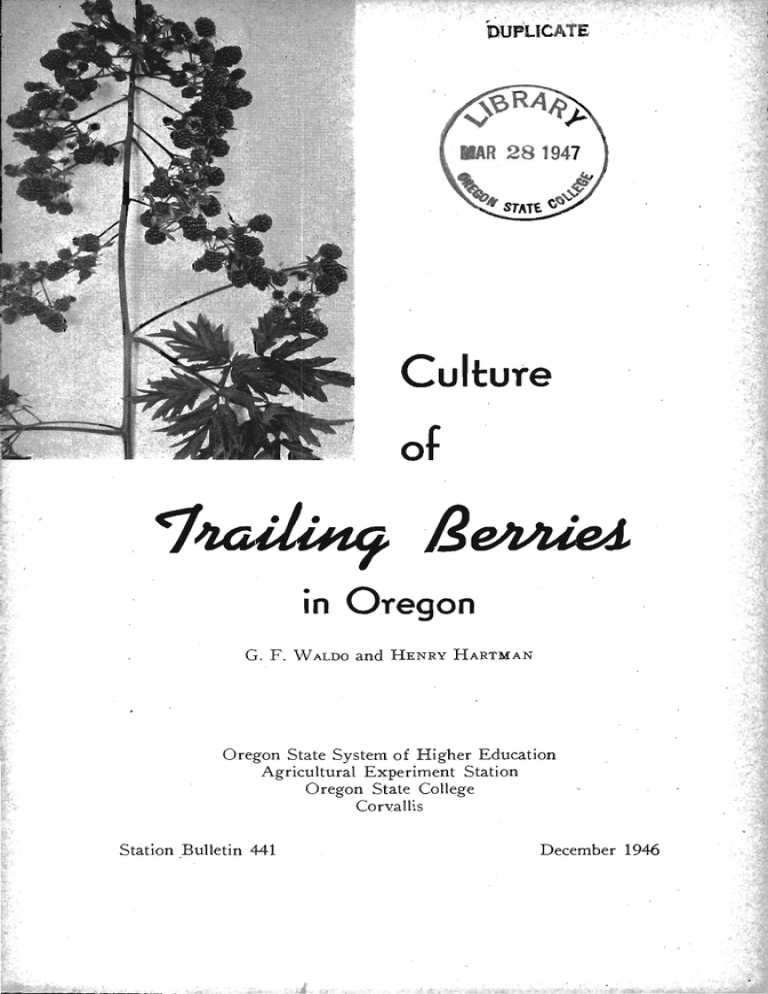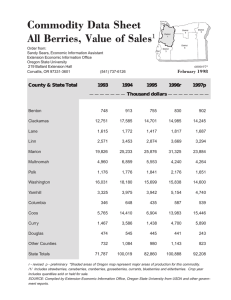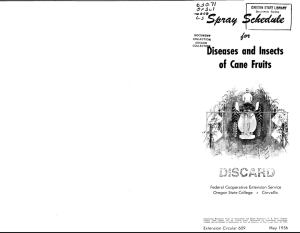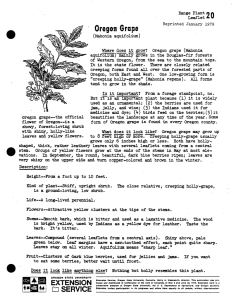&IiKç I2e44ieS Culture of in Oregon
advertisement

I UPLIC NAR 28 194 STAT Culture of &IiKç I2e44ieS in Oregon G. F. WALDO and HENRY HARTMAN Oregon State System of Higher Education Agricultural Experiment Station Oregon State College Corvallis Station Bulletin 441 December 1946 FOREWORD During the latter part of the war and especially during the postwar period thus far, there has been an increasing demand on the part of Oregon growers or prospective growers for in- formation on the production of small fruits. This demand has stemmed from the present high prices being paid for these fruits and the fact that parts of western Oregon are exceptionally well suited for their production. The peak production of small fruits in Oregon was reached in 1941 when over 25,000 acres were in plantings, and a production of approximately 83,000,000 pounds was obtained. Acreage and production fell rapidly during the next three years, however, dropping to about 16,500 acres and 48,000,000 pounds production in 1944. The production of these crops is definitely on the increase again, with many former producers reestablishing old plantings and many new ono entering the industry. In order to help answer the many questions that will confront these growers, this bulletin and two others, Station Bulletin 442, Strawberry Proin. Oregon, and Station Bulletin 443, Raspberry Culture in Oregon, have been pre- duction pared. Dean and Director TABLE OF CONTENTS Page Establishment costs hih S Location of plantings Producing areas of the state Consideration of market factors Selecting a site Soil requirements 6 Varieties Choosing the variety New varieties 7 6 6 7 7 7 8 Principal varieties grown in Oregon Note on thorniessness 8 12 Establishing the plantation 12 Preparing the soil 12 Handling the plants prior to planting 13 Recommended planting systems Time of planting 13 Setting the plants 14 14 Care of the soil 15 Cultivation 15 Fertilization Cover cropping Irrigation 15 16 16 Managing the growing canes Training new canes Removal of old canes Time of training Method of training Training to stakes Training to a single-wire trellis 17 17 17 18 18 18 19 Training to the 2-wire vertical trellis 20 Training to horizontal trellis 24 Harvesting 26 Insects and diseases 27 Cover illustration A heavily laden cane of the Evergreen blackberry variety that grows wild in the pastures arid woodlands of Oregon. 4 Culture of Trailing Berries in Oregon (Boysen, Young, Logan, Cultivated Blackberries, and Others) By G. F. WALDO and HENRY HARTMANt TRAILING BERRY INDUSTRY, of which the Logan, Boy- sen, Young, and the Evergreen blackberry are the principal OREGON'S varieties, has been receiving increased attention from many growers in the state in the postwar period. This industry is centered in the Willamette Valley counties of western Oregon. The area's natural climatic conditions, a mild autumn and winter and warm dry summer with sufficient spring moisture to develop the fruit, favors the production of these berries. The dry summer allows harvesting without loss from moldy or decaying berries, and the mild but moist autumn weather favors cane growth and propagation by tip layering. The Boysen, Logan, and Youngcommonly called Boysenberry, Loganberry and Youngberry in Oregonmay have originated from, or at least are closely related to, the native trailing blackberries of the Pacific Coast. The eastern trailing berries, known as dewberries, are also very similar. The Evergreen and Himalaya blackberries are less closely related, being of European origin, but after introduction, they have become naturalized to our conditions. The cultural practices described in this bulletin apply to the type of berry that produces a vine or cane that trails along the ground and propagates itself by taking root at the tip of the cane. Fruit is produced the second year after which time the vine or cane that bore the fruit dies. ESTABLISHMENT COSTS HIGH The cost of establishing commercial trailing berry plantings is a factor that should be considered by all prospective growers. It has been estimated that under 1946 prices, initial cost may go as high as $1,000 an acre. Prospective growers should realize also that new This publication is based on cooperative investigations by the Division of Fruit and Vegetable Crops and Diseases, Bureau of Plant Industry, Soils and Agricultural Engineering, Agneultural Research Administration, U. S. Department of Agriculture, and the Oregon Agricultural Experiment Station. The authors express appreciation to Mr. R. M. Alexander for his assistance in the preparation of this bulletin. f Pomologist, Division of Fruits and Vegetable Crops and Diseases, Bureau of Plant Industry, Soils and Agricultural Engineering, Agricultural Research Administration United States Department of Agriculture; and Horticulturist and Head, Department of Horticulture, Oregon Agricultural Experiment Station; respectively. 6 STATION BULLETIN 441 plantings cannot be expectedto reach full production for about three years. In addition, land prices are inflated in many of the producing areas. Careful consideration should be given, therefore, to the question of whether some crop other than trailing berries might not be more desirable under present conditions. The establishment costs of a trailing berry planting involve the cost of preparation and later cultivation &f the soil, planting stock, wire and posts for trellising, and labor costs. The purchase of special equipment or implements may be necessary also. Because of this high investment, prospective producers should give careful consideration to the factors that will affect the probable life of the planting and to the yields that can be obtained. The factors that seem most vital to successful operation are presented in this bulletin as a guide to those contemplating new plantings. LOCATION OF PLANTINGS Producing areas of the state The trailing berry industry is centered in the Willamette Valley with Marion, Multnomah, and Clackamas counties as the leading areas. Of the state's approximate 4,430 acres of plantings in 1944, 92 per cent were in the nine Willamette Valley counties. The breakdown of this acreage by the different berries showed 2,500 acres in Boysens and Youngs, 1,250 in Logans, and 680 in tame blackberries. Consideration of market factors Plantings of some of the trailing berries are often made before a real market or outlet for the crop has been established. Because of the high quality of these berries, a market usually has developed by the time the planting reached full production. However, large plantings are not recommended under such conditions, especially if the planting is of a new variety. Large quantities of Boysen and Young are consumed fresh in the local markets. Considerable amounts are also frozen and canned. The Logan has been marketed in various ways in the past, bit at the present most of the berries are used in juice and winemaking. The Evergreen and other blackberries are frozen or canned for the most part. In general, the trailing berries, with the exception of the Evergreen blackberry, are too soft to be shipped any great distance. For this reason, planting.s' should be made relatively close to the market outlets. CULTURE OF TRAILING BERRIES 7 Selecting a site In general, trailing berries can be grown on a wider variety of sites than can most of the other small fruits. Since many of the varieties being grown now are relatively new, adaptation requirements for all trailing berries have not been fully determined. How- ever, steep hillsides and light soils that dry out quickly are known to be undesirable. Sufficient moisture to bring the fruit to maturity is not usually provided by such soils. When these berries are planted in a favorable location, they can be expected to occupy the same ground for as many as 15 to 20 years or more. For this reason, careful czrnsideration should be given to selectin.g a site that can be considered permanent. Soil requirements The native trailing blackberries are found growing on nearly all the soil types of western Oregon. The cultivated varieties are adapted also to most of the soil types, but are found to yield best on the more naturally fertile types that are deep, well-drained, and have a subsoil that is loose enough to allow proper root penetration. Most of the commercial acreage is found in the deep, fertile hill soils and the well-drained valley soils of the Willamette and Chehalis types. Varieties such as the Logan, Boysen, and Young have often failed on the lighter hill soils, although when ample provision has been made for maintaining soil fertility and moisture, good yields can be obtained. These berries have generally failed on the poorly drained clay soils. The Evergreen has probably succeeded better than any other on these heavy soils. VARIETIES Choosing the variety Much of the success in trailing berry production depends upon the right choice of varieties to grow. In the past some varieties, the Logan in particular, were so heavily, planted that markets were not able to take all the production. No rule, therefore, can be laid down regarding the choice of a variety to meet the market requirements. New varieties that have merit often make a place for themselves after having been planted. On the other hand, the planting of varieties already well established may result in overproduction, or newer varieties may become more popular. In addition to the above factors, a grower must also consider the adaptation of the variety to his particular locality and soil type, as well as the possible yields, cost of production, availability of labor, and other factors. STATION BULLETIN 441 8 New varieties The trailing berries, in comparison with other fruits, are relatively new. The Logan, the oldest variety of importance in Oregon, has been in cultivation for only about 50 years. The Young has been in cultivation less than 20 years, while the Boysen was introduced about 10 years ago. Many new varieties are now appearing, some of which have merit and possibilities. New uses and new products may be developed whereby a number of varieties may be grown for different purposes. As growers are not in a position to develop these new outlets, large plantings of new varieties are not advised unless a market is assured. Small garden or home plantings, however, offer opportunities for testing these new varieties to determine their adaptation and possibilities. Principal varieties grown in Oregon BoysenCalifornia originis being widely grown in Oregon at the present time. The plants are generally vigorous and productive. This variety is fairly hardy and can even be grown in certain sections of eastern Oregon, though winter injury can be expected in the colder weather. The fruit is very dark red and begins to ripen later than that of the Logan or Young, but the season does not last much longer. The berries are among the largest of the small fruits and are somewhat firmer than Logan. The Boysen is very desirable for local markets. It is used also in freezing and canning. The flavor is excellent, subacid to acid. Brainerd is a United States Department of Agriculture introduction, resulting from a cross of the Himalaya and an eastern upright blackberry. The cane growth is very vigorous and hardy, and the fruit production is good. The berries ripen after the Boysen and Logan, but before the Evergreen. The berries are large and quite firm, with good flavor that is characteristic of the eastern blackberries. Growers sometimes object to the extreme vigor of this variety, however. Cascade (Figure 1)Oregon originis a recent introduction resulting from the cooperative breeding project of the United States Department of Agriculture and the Oregon Agricultural Experiment Station. Cascade originated from a cross of the native trailing blackberry variety, Zielinski, with the Logan. The plants are vigorous and very productive but not hardy enough for eastern Oregon. The berries, dark red and slightly smaller than Logan, are somewhat soft and not suitable for fresh market purposes. The characteristic wild blackberry flavor is excellent. Except for its softness, it is well CULTURE OF TRAILING BERRIES Figure 1. The Cascade blackberry, a recently introduced cross from the Experiment Station's cooperative breeding project has many merits. The white hand near center of picture is a six-inch ruler. suited for canning and freezing. It ripens at the same time as the Logan. Cory Thorniess (Bowen)California originis a thorniess variety of the Mammoth blackberry which is not grown to any extent in Oregon. The berries are quite large, black, and acid without any characteristic flavor. EvergreenEuropean originwas introduced into Oregon early and since its introduction has become naturalized in the wild in western Oregon. Thickets of this variety are often a nuisance in pastures, woodlands, and along roadsides. Much of the production has been, and to a certain extent still is, from the wild variety. Since the introduction of the red berry mite, however, much of the wild fruit does not ripen. Cultivated plantings can be sprayed to control this pest. The fruit is firm and has good flavor. Considerable quantities are canned, and a small amount is shipped fresh to distant markets. Heavy yields are often obtained, especially when irrigation is used. This variety ripens in August and September. Himalaya (Theodor Reimers)European originis a very vigorous European variety which after its introduction became naturalized. Thickets of this variety are even more of a menace than Evergreen. Although it is very productive, there are very few commercial plantings. The fruit is soft, of good, mildly acid flavor, and used mostly in canning. Its season is between that of Boysen and Evergreen and slightly later than that of Brainerd. STATION BULLETIN 441 10 LoganCalifornia originplantings are vigorous and productive when well cared for. The berries are medium to large in size, dark red in color, medium firm to soft in texture, and have a good flavor which is classed as subacid to acid. Logan has been extensively grown, but in recent years the Young and Boysen have largely replaced it. It is still being grown for juice and winemaking. The softness of the berry and its high acidity have been its chief drawbacks in the past. It does have, however, a very attractive flavor. The Logan usually begins to ripen June 15 to 25 and continues during most of July. LucretiaWest Virginia originis the oldest, as well as the principal, dewberry variety of the eastern states. Its growth and production is satisfactory in Oregon, but its berry qualities are not considered comparable to the Boysen, Logan, and Young group. Very few are grown in Oregon. It is hardy, however, and may be grown in parts of eastern Oregon where others suffer much winter injury. It ripens a little before the Logan. MammothCalifornia originis a very vigorous and productive variety which produces berries nearly as large as Boysen and Nectar. The berries, however, are quite acid and do not have an at- Figure 2. The Pacific blackberry, promising new variety, is of the Logan type, with the flavor of the native trailing blackberry. CULTURE OF TRAILING BERRIEs 11. tractive flavor. Very few are grown in Oregon. Its season is about the same as the Logan. NectarCalifornia originseems to be identical with Boysen in every respect. Some believe that the fruit is larger and that it has a more pleasing flavor (less acid) than the Boysen. In growth and appearance, the two plants are very similar, also. Pacific (Figure 2)Oregon origin.-is another recent intro- :i duction from the cooperative breeding work with the United States Department of Agriculture at the Oregon Agricultural Experiment Station. Its origin is the same as that of the Cascade and in most respects the plants are quite similar. Under some conditions, however, it seems to be less vigorous than Cascade. The fruit is similar, but is slightly larger, firmer, and possibly more acid. It alsb has a characteristic flavor, suggestive of the native trailing blackberry. The season is the same as for Cascade and Logan. Santiam (Ideal Wild)Oregon originis in many respects similar to Cascade. Its origin is not definitely known. Its growth characteristics are, however, very similar to the known crosses between Logan and the native trailing blackberry. The canes, somewhat smaller and more vinelike than most of the trailing berries, are quite similar to those of the native blackberry. The berry is smaller than Cascade or Pacific and is rather soft. The flavor is excellent and characteristic of the native blackberry. The yield is not equal to that of Cascade or Pacific, and the plant is also quite susceptible to cane and leaf spot disease. It ripens slightly earlier than the Logan. Thorniess BoysenCalifornia origin is supposed to be a thornless form of Boysen, but all plants observed have been similar to the thorniess Young in every respect. Thorniess EvergreenOregon originis a thornless form of the Evergreen that has been planted to a considerable extent especially in the East. Thornlessness in Evergreen is of considerable importance as the cost of handling, especially training, is greatly reduced., The thorns of the Evergreen are much more objectionable than those of Boysen, Young, or Logan. Thorniess LoganCalifornia originis a thornless form of the Logan. In other respects it is identical with Logan. It is becoming quite popular as yields are apparently equal to those of the Logan. Thorniess YoungCalifornia originis a thorniess form of Young. It is considered identical with Young in every other respect. 12 STATION BULLETIN 441 YoungLouisiana originenjoyed great popularity for a few years after its introduction into Oregon in 1926. Since the introduction of IBoysen, however, it has been losing favor. The Young is generally quite vigorous, but under some conditions yields have not been comparable with its vigor. Injury to the canes and buds from lying on the ground during the moist winters has sometimes been serious. Growers have avoided some of this trouble by fall training. The berries ar large, dark red in color, and have an excellent flavor quality which is milder and less acid than Boysen. Much of the production has been canned and frozen. Its season is the same as the Logan. Note on thorniessness The thornless varieties mentioned in this publication have originated as chimeras.* The perpetuation of these forms must be by the rooting of the tips of the canes. Shoots from the roots always bear thorns. Great care should, therefore, be observed in cultivating these thorniess varieties to prevent cutting the roots, as shoots often arise from these cut or damaged roots and are always thorny. Thornless canes in a thorny variety are usually rare, but such occurrence has been observed more often in the Young than in other varieties. Yields have been more variable in the case of the thornless types than in the thorny. It is commonly reported that thornlessness is associated with lowyields. This, however, is not always true as occasionally the thorniess forms have exceeded the thorny in yields. ESTABLISHING THE PLANTATION Preparing the soil Most trailing berry plantings are made on soils that are naturally fertile but which have been cropped for so long that they have become depleted of organic matter. In such condition, the soil has less ability to hold fertility and moisture and is more difficult to work. To remedy this, some form of organic matter should be incorporated into the sOil before plantings are made. Barnyard manure is considered the best source of both organic matter and fertility for the soil. Certain materials, such as rotted straw, pea vines or similar crop residues can also be used. As these materials are not always available, the plowing under of cover crops is the most widely used practice. Covef crops of oats, barley, or rye with a legume such as vetch or Austrian field peas are the most cornA plant of mixed genetic makeup. With trailing berries, the outer tissue of the cane is thornless, while the center tissue of both thk canes and roots have the characteristics of thorniness. CULTURE OF TRAILING BERRIES 13 mon. The growth of these cover crops can be greatly increased by the use of commercial fertilizers. A greater volume of material is plowed under and the fertilizing materials become available for plant use again as the cover crop decays. Growers should follow local reèommendatjons for the type and amount of fertilizer to use. When a fall cover &rop is grown, the land should be plowed two or three weeks before the berry plants are set in the spring. Fall plowing may be preferable if the land is not in cover crop or if there is no danger of soil washing. Plantings can be made earlier in the spring if the land has been fall plowed. Handling the plants prior to planting Trailing berry plants are nearly always tip-rooted ones that have resulted from the tip of the cane taking root the previous autumn. Such plants have usually developed a strong enough root system by early spring so that they can be separated from the attached cane. Care must be taken in digging, as well as in setting these young plants, to prevent the growing point or new shoot from being injured. Such a damaged plant will usually survive, but growth is considerably delayed. Great care should also be exercised to keep the young plant roots from drying out. lithe weather is quite warm at planting time, it may be advisable to dip the plants in water before setting them. Plants that have dried out excessively in shipment can be soaked in water for a few hours before planting. It is usually best to plant as soon after digging as possible, although plants can be satisfactorily held a few days by heeling them in. This is done by placing the platts with their roots well spread out in a v-shaped trench. The plant is then covered with soil until only the tip or growing point is left uncovered. When a new planting is to be made relatively close to the old one from which the planting stock is to be obtained, the new plants can usually be moved without removing the soil from around their roots. This procedure will enable the young plants to become established earlier, and fewer losses will result. Recommended planting systems Several factors should be considered in determining the planting system to be used, and the distance the plants are to be set apart, both in the rows and between rows. The type of training, the cultivation system to be adopted, and the vigor with which the plant grows, must all be considered. On slopes subject to erosion, planting across the slope or on the contour is also advisable. If ordinary wire trellises are to be used, the rows should be from 6 to 10 feet apart depending on whether a narrow garden cul 14 YLJ1 STATION BULLETIN 441 tivator or some wider type is to be employed. Growers who use trac- tors now prefer to set rows farther apart than formerly; 9 to 10 or 12 feet apart is quite common. The plants are usually set 8 to 12 feet apart in the rows with the wire trellis system. The more vigorous varieties, such as the Himalaya and Evergreen blackberries, are generally set farther apart in the rows, as much as 12 to 16 feet apart. Plants to be tied to a single stake can be set on a square systeni, so they can be initially cultivated in two directions. After the new cane growth starts, however, cultivation can be in only one direction. The closer the plants are set under this system, the greater the yield per acre. For ease in cultivation, though, they should not be set closer than about 6 x 6 feet. When large tractor cultivation is used, the plants may have to be 8 x 8 feet or more apart. To insure a more uniform planting, a system of putting a stake at each place a plant is to be set. and aligning the plants is recommended. This, or some similar system, will aid the appearance of the planting, as well as make cultivation easier. Time of planting Since trailing berry plants naturally take root at the tips of the canes in autumn, it is usually necessary to do all planting the following spring. The root development takes place during both autumn and winter. The development is especially good in the earlier period if the weather is mild, and the rains have come early. Conditions unfavorable for autumn and winter root development sometimes occur, however. When this condition prevails, plants dug early in the spring may not have sufficient roots for transplanting, so later digging is advisable. Setting the plants Plants are nearly always set with a spade or shovel. When the plants have had all soil removed from their roots, they may be set by plunging a spade into the ground and moving it forward enough to allow the roots to be pushed down and spread out in the opening. As the spade is drawn out, the soil falls back in the opening on the roots. The soil next to the plant should be firmed with the feet to prevent large air spaces from remaining to dry out the roots. Where plants are moved with the soil attached, a larger hole must be dug. If growth has not started, the growing point of the shoot may be covered with about an inch of soil. If new leaves have begun to appear, however, they should not be covered. CULTURE OF TRAILING BERRIES Figure 3. 15 Higher yields can be expected when plantings are properly maintained, as in the Logan field above. The rope system of trailing has been used. CARE OF THE SOIL Cultivation Cultivation should follow planting as soon as weed growth begins and should be practiced thereafter as weed control is needed. Deep cultivation should be avoided. Many fine feeder roots are cut by deep cultivation. Early control of weeds and grass in spring is very essential. The grape hoe can be effective for this purpose in trailing berry plantings. Various types of cultivating tools may be used also with the disk and spring-tooth harrow being the most common. Some hand hoeing is necessary to get weeds and grass growing close to the plant. Cultivating tools should not be allowed to break or damage canes or fruit. Fertilization It is well known that the fertility of trailing berry plantings can be maintained, and in most instances increased, by the use of manure and cover crops. Manure has been the most practical method. An- nual applications of about 10 tons per acre applied in late fall or early spring may be made with good results. Poultry manure is usually applied in lesser amounts. Manure, however, is not as avail- 16 STATION BULLETIN 441 able as formerly and cover crops and commercial fertilizers are being used more often. It is becoming evident that commercial fertilizers cannot entirely replace manure and cover crops. They may, however, be valuable supplements. Phosphorus is not always available in barnyard manure and may be added in the form of a commercial fertilizer when the manure is applied. Fertilizers containing nitrogen, phosphorus, and sulphur have been found to increase the growth of cover crops. In some cases potassium has been found to be a valuable addition. Studies on the use of commercial fertilizers without the addition of organic matter have given variable results, and no general recommendations, therefore, can be made. Often low yields are obtained on apparently fertile soil because of the depletion of one necessary element. To determine just what is lacking is often difficult for the grower, but the addition of organic matter usually makes available most of the elements necessary for plant growth. Because of the variation in fertilizer requirements in different localities and on various soil types, growers are advised to follow the recommendations of their local county agricultural agents. Cover cropping Oats with vetch or Austrian winter field peas is used extensively in berry plantings. Many other cover crops, however, may be used. To supply organic matter alone, winter barley or giant winter rye will give more volume than oats. Willamette vetch is usually considered the best variety of legume to use at the present time. Crimson clover may be used also on some soils. Cover crops should ordinarily be seeded with a small drill in late summer, just about the time the autumn rains begin. Fertilizers to aid the growth of cover crops have given the greatest response when applied in February. Cover crops should be disked or plowed under in spring before they begin to compete with the berry plants for moisture. It is prob- ably best to disk down the cover crop without plowing, as plowing may cut off too many roots of the berry planting. Cover crop refuse on top of the soil is not objectionable unless it materially interferes with the control of weeds during the summer. Irrigation In southern Oregon and wherever these berries are grown in eastern Oregon, irrigation is necessary for proper growth. In these s.ections surface irrigation is practiced with water applied in furrows along each side of the row. These furrows, about 5 inches deep CULTURE OF TRAILING BERRIES 17 and 12 to 18 inches from the center of the row, are kept filled with water until all the surface soil between the furrows has been wetted. Considerable water is needed in the summer to develop the fruit properly. Only enough water is needed in late summer to keep the plants growing vigorously. Irrigation is not practiced much in western Oregon. It is well known, however, that much greater yields of all crops can be obtained by irrigation. Many farms of western Oregon are equipped with sprinkler irrigation systems which are being used successfully. MANAGING OF GROWING CANES The management of trailing berries involves taking care Of both the growing canes in their first year and the fruitproducing, oneyear-old canes. The canes bear no fruit until their second year. In the autumn of the first year or spring of the second year they are trained up to trellises or stakes so the fruit will be off the ground and can be conveniently picked. Following the harvest season, these old canes are cut off and removed. Training new canes New canes come out from the crown of the plant in the spring. These must be placed so that they will be out of the way of cultivation and picking. To accomplish this, they are bent down and laid lengthwise along the row when they reach a length of 3 or 4 feet. They are held in place by stakes about 2 feet long or by wires bent in a U-shape and pushed into the ground above the canes. Training is usually easier if all the canes on one side of the row can be laid in the same direction. Laying the canes from the entire plant in the same direction might be still better. Great care, however, must be taken in bending canes to prevent breaking, partial breaking, or even forming sharp angles which may break later. Many branch canes are formed whenever a cane is broken. These branch canes are usually slender and only increase the number to be handled in training. Removal of old canes The old fruiting canes usually should be removed as soon as the crop has been harvested. Most varieties of the trailing blackberries are more or less susceptible to leaf and cane spot disease. The early removal of the old canes reduces the sources of further infection. These canes should be cut as close to the ground as possible and taken out of the field to be burned. Some growers use a cover crop disk to break up the canes and work them into the soil. They believe 18 STATION BULLETIN 441 that such a practice adds organic matter to the soil and makes a heavy soil easier to work. When leaf and cane spot disease is not a serious menace, leaving the old canes until time for training the new canes may save some labor. Time of training The young canes of the trailing berries are put up or trained in either late summer and early autumn or in late winter and early springAugust through October in the autumn or January through March in the spring. Many varieties, particularly the Young, have often been found to die back from the ends of the canes and to have certain buds killed when the canes are left lying on the ground until spring. This condition has been particularly serious when autumns and winters have been wet and mild. When such conditions prevail, canes trained up in the fall show less injury and give a larger yield than those left on the ground. Injury from cold, however, may be very serious if canes are trained in the fall before low temperatures occur. Some growers feel, however, that since mild rainy winters are more common, fall training is more proatable over a period of years even though a loss may occasionally occur. The canes of some varieties, particularly Young, are injured more than others by lying on the ground during the rainy winters, so fall training with these varieties is especially advisable. Method of training Several different systems are used in training the trailing berries. The system to be used will depend on the variety, the size and pur- pose of the plantingwhether for commercial or home useand various other factors. The main systems of training to stakes, to the sirfgle-wire or 2-wire trellis, and to the horizontal trellis, are described in the remainder of this section. One point that should be considered in training, too, is that the central portion of the cane of most varieties of trailing berries is the part that bears the most fruit. The terminal or outer ends of the canes can usually be cut off without greatly reducing the yields. Size of the individual berries is often greatly increased when as much as one half or more of the cane is cut off. The number of berries that will be produced is always reduced when any portion of the cane is cut off, however. Training to stakes Some growers prefer training to stakes instead of the wire trellis system, as cultivation during the early summer may be in two CULTURE OF TRAILING BERRIES Figure 4. of stake method of training when a cross arm Fruiting canes are on stake and growing canes on the ground. Diagram 19 is used. directions, thus eliminating hand labor. Under the stake system, too, more plants can be set per acre, which often means higher yields. The best stakes to use are 2" x 2" cedar or split cedar posts. These are sharpened at one end and driven into the ground. Stakes should be from 5 to 6 feet above the ground. Sometimes a cross arm is nailed to the top of the stake. This arm may be from 1 to 2 feet long. Canes are tied with two or three ties to the stake (Figure 4). Where the cross arm is used, the canes may be looped over the arm and the ends of the canes cut off. If no cross arm is used, only about 6 feet of cane is left for fruiting while 7 to 8 feet of cane is left if a cross arm is used. Longer canes generally produce higher yields, but the berries are smaller. This system of training to stakes is quite practical in the home garden. Training to a single-wire trellis Many commercial growers prefer a single-wire trellis system of training. With this method a heavy wire is strung very tightly on posts 16 to 20 feet apart. The wire is usually about 5 or 5 feet above the ground. The canes are taken up and twisted along the wire in either one or both directions from the plant (Figure 5). The ends of the canes may or may not be cut off. Canes of Boysen, Logan, and Young plants, when set from 8 to 12 feet apart in the row, need to be left 9 to 12 feet in length for fruiting. 20 STATION BULLETIN 441 Figure 5. Diagram of canes trained to a single wire. Fruiting canes, above; growing canes, below. One of the objections to this method is that many canes are wrapped together around a single wire. Lnless a very heavy, tightly stretched wire is used, there is danger of its breaking down. Breaking down may also occur if canes are not properly tied to the wire. However, the high single-wire trellis gives more room for hoeing and training-back operations and all the berries are in one place for the pickers. Training to the 2-wire vertical trellis The 2-wire vertical trellis is the most common of the trellises used in Oregon. In this system cedar posts are set from 16 to 24 feet apart along the row. Large posts may be set farther apart and smaller posts or stakes set every 10 or 12 feet between. The end posts are well anchored or braced. Two wires are stretched between posts, the upper wire about 4 to 5 feet above ground and the lower wire about 2 feet below the upper one. Various methods of attaching the wire to the posts are used. Large staples or nails are often used, but these sometimes pull out under a heavy load of fruit. One solution is to stretch the upper wire along the top of the posts. The wires may also be passed through holes bored in the posts or rest in notches cut into the side CULTURE OF TRAILING BERRIES Figure 6. 21 Diagram of the weave or wreath system of training canes to the 2-wire trellis. of the posts. Wires usually need restretching each year before training. The method of attaching the wire to the end posts should be one that will allow tightening of wires each year. There are various ways of training canes to the 2-wire trellis. No definite names have been given to these methods. The names given here are those which seem most logical to the authors. The weave or wreath system (Figure 6) has been used extensively in Oregon until recent years. In this systenl a few canes, usually one to three, are taken together and passed from upper to lower wires and back again to form circles or wreaths. All the space between the wires is utilized in this system. Sharp bends or curves causing damage to canes are avoided. More time is consumed in training with this method than with some of the others described here. The loop system (Figure 7) is probably most common at the The canes from a single plant are divided into two parts and each part is taken separately to the top wire, one or two twists around the wire are made and then the cane is brought down to the lower wire and turned back toward the plant with one or two present time. twists. The excess length of canes is usually cut off when they reach the upright portion of the canes. The other half of the canes is looped on the other side of the plant in a similar manner, thus form- 22 STATION BULLETIN 441 Figure 7. Diagram of the loop system of training canes to the 2-wire trellis. ing a double loop. Canes can be trained quite rapidly to this system. Plantings using this system have a very uniform and attractive appearance (Figure 8). The half loop or interlocking system (Figure 9) is similar to the above loop system except that the canes are not turned back toward the plant. Instead they are brought down to the lower wire and interlocked with the canes of the next plant. The portion of the canes left at the point of interlocking is cut off. Canes about 9 or 10 feet long are left in this system when plants are set about 8 feet apart. The rope or 4-arm system (Figure 10) is obtained by dividing the canes into four parts and extending them along both wires. Usually the longer canes are taken to the top wires. Canes may be cut off and tied at the point of intersection with those of the next plant or interlocked with them. This method usually requires more time in training than the two ioop systems. A variation of this method is quite practical in handling the Brainerd blackberry and other vigorous varieties having a similar habit of growth. This system consists of pinching off or cutting the terminals of the new canes just after they have reached the top Figure S. Blackberries trained to the loop System give appearance. Figure 9. a very uniform and attractive Diagram of the half ioop or interlocking system of training canes to the 2-wire trellis. 23 24 STATION BULLETIN 441 Digrans of the rope or 4-arm system of training canes to the 2-wire trellis. Figure 10. wife. Strong lateral branches will then be produced below the point of cutting very similar to those of the black raspberries. These lateral branches may then be trained along the upper and lower wires at the time of training. Some branches coming out at right angles to the row may have to be cut off as these canes cannot be bent without breaking them. The fan system, as used in some parts of the country, consists of bringing up individual canes to the wires in the form of a fan. The canes are tied to the wires or sometimes interlocked and twisted along the upper wires. system. Much tying is usually necessary in this - Trailing to the horizontal trellis The vigorous varieties, such as Evergreen, Himalaya, and Mammoth, are often trained on two horizontal wires on which are placed cross pieces of wood or wire to support the canes. There are also various systems of handling the canes on these trellises. The 2-wire horizontal trellis (Figure 11) is a system in which 2 wires are supported on crosspieces nailed to the posts. These crosspieces are from 1 to 2 feet in length. Other crosspieces of wire or Figure 11. Figure 12. Evergreen blackberries trained to the single 2-wire horizontal trellis. Diagram of the method of training to the 4-wire horizontal trellis. Fruiting canes, above; growing canes, below. 25 26 STATION BULLETIN 441 wood are laid on the wires and the canes are placed on them. Placing the crosspieces both above and below the canes will hold them in place quite securely. In this system the wires are about 4 to 5 feet above ground. The 4-wire horizontal trellis (Figure 12) consists of 2 pairs of horizontal wires, the lower pair placed about 2 feet below the upper pair. When a trellis of this type is used, the new canes of the current season are not allowed to grow along the ground. If the fruiting canes are placed on the upper wires, the new growth is trained along the lower wires. These canes may be either taken up to the upper wires after the old canes have been removed or left to fruit on the lower wires. In this case the new canes are trained up to the upper wires where they remain until after they have fruited. HARVESTING Most varieties of the trailing berries begin to ripen during the latter part of June with the season continuing during most of July. Some varieties ripen in late July and August, and the Evergreen ripens during August and early September. Pickers are often equipped with a box-like container holding two berry boxes which is tied to the waist and into which the berries are placed as picked. Sometimes picked berries are placed directly into the carriers (Figure 13). The carriers often have legs about a foot or more in length. It is very important that the berries be protected from the direct rays of the sun after they have been picked. Carriers should be taken to the packing shed as fast as they are filled. The amount of fruit that can be picked by one person will vary greatly. Picking is easier and faster when the berries are large and stand out from the canes and leaves. Varieties such as the Boysen, Logan, and Young require about 4 to 5 pickers per'acre throughout most of the season. In large plantings requiring a large number of pickers the grower or a responsible person should be in charge of the picking crew. There should be careful supervision to see that all berries picked are of the desired maturity. Overripe, immature, decayed, and otherwise undesirable berries should not be picked. Varieties like Boysen, Logan, and Young are usually picked every three or four days. If the weather is very warm, however, they should be picked every other day in order to prevent losses from berries becoming overripe. Longer intervals between pickings are possible in the cooler weather which usually prevails when the Evergreen blackberries are ripening. CULTURE OF TRAILING BERRIES Figure 13. Harvesttng Logans. 27 Each picker should be provided with a carrier similar to the one illustrated. Packing sheds should be conveniently located so that carriers need not be carried far, and should be arranged so that all operations there can be carried on in the shade. In the packing shed berries are weighed and a record kept of the amount picked by each picker. The berry boxes are transferred from the carriers to the crates. Ample space should be provided for the stacking of filled crates in the shade, until they are loaded for market. Some responsible person should be placed in charge of the packing shed operations. INSECTS AND DISEASES There are relatively fewer insect pests and diseases of the trailing berries in Oregon than of strawberries and raspberries. Certain insects and diseases-are present, however, and the grower should take all the necessary measures for their control. Information and control recommendations are given in Oregon Agricultural Experiment Station Bulletin 418, Diseases and Insect Pests of Cane Fruit; in Oregon, by S. M. Zeller and Joe Schuh.






